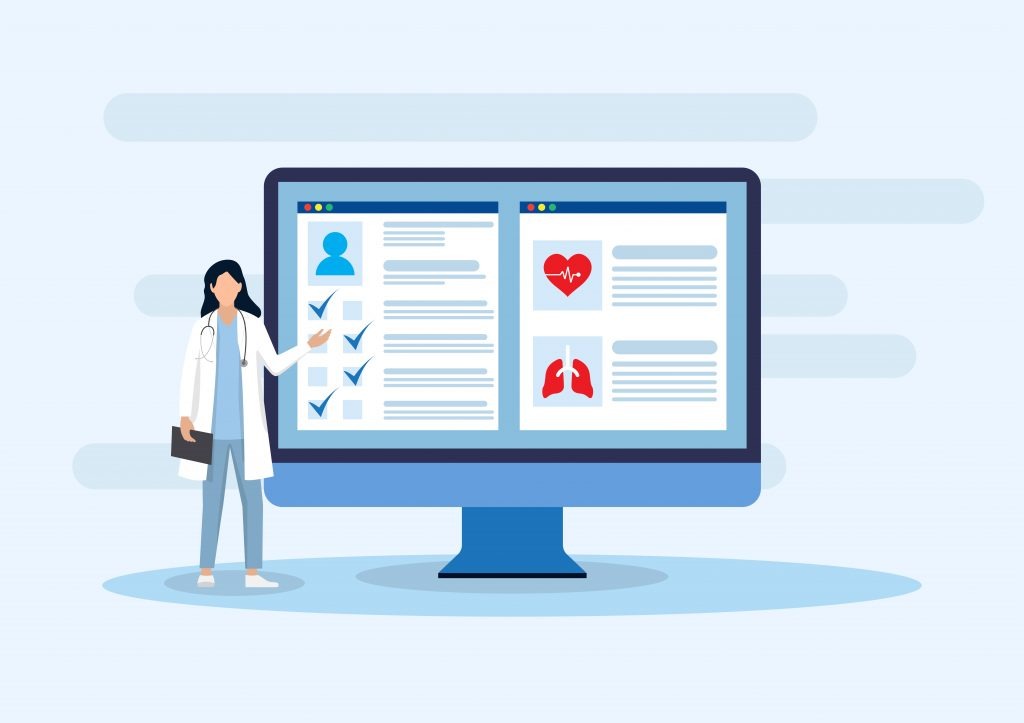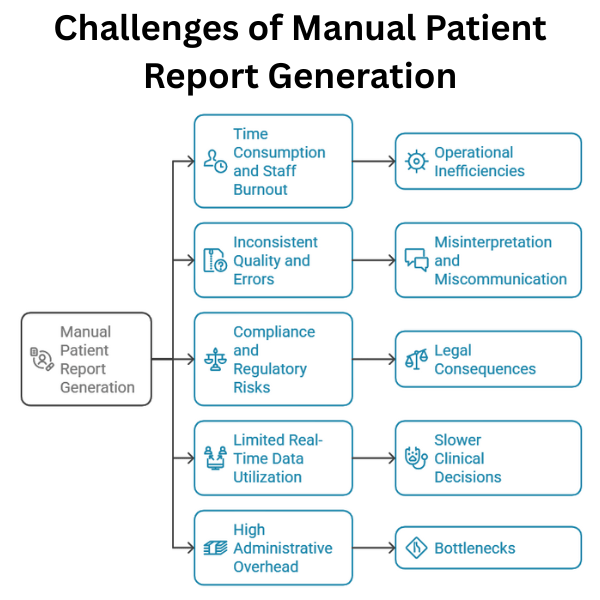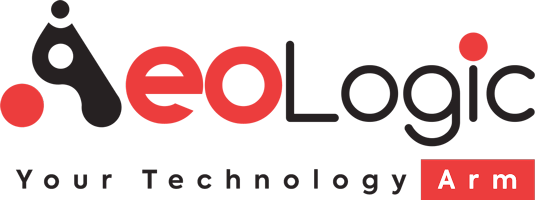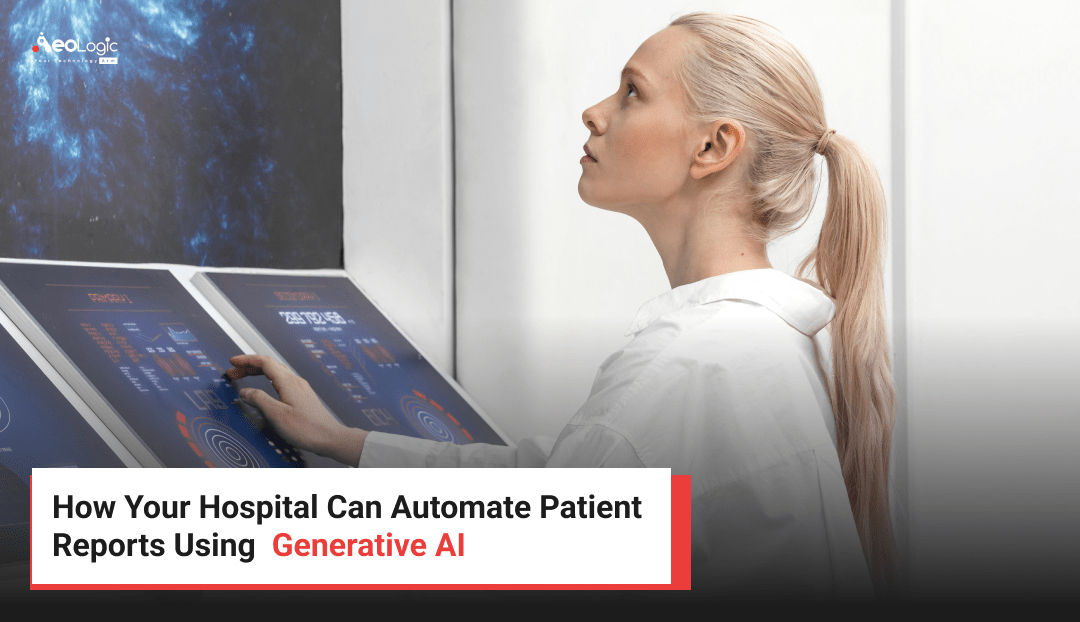In a time when healthcare needs speed and accuracy, hospitals are bogged down by administrative responsibility, and patient reports are one of the largest consumers of time.
Doctors, nurses, and administrators often spend many hours each week manually creating patient data and patient reports, discharge notes, and diagnostic interpretations. The processes are time consuming, prone to delays, duplicates, and human error. With increasing volumes of patients and complexities of health systems, the need for scalable, intelligent solutions is more pressing than ever. That’s where generative AI solution can help. And it is already helping to automate documentation of patient reports and improve operational efficiencies to maintain speed and accuracy.
By leveraging generative AI technology, hospitals can reduce documentation time, improve accuracy, and maintain consistency from clinical records to reports. Whether via auto-generating post visit summaries, or highlighting key findings for radiologists and other related specialty providers, AI-enabled healthcare automation will fulfill rules and regulations, clinical protocols, and standards of care while reducing the burnout of clinicians.
Let’s explore the solution of how healthcare automation technology is changing the future of report and documentation work, and begin with defining clearly what generative AI is, and its role in the healthcare ecosystem and emerging technologies.
What Is Generative AI in Healthcare?

Generative AI represents a family of Artificial Intelligence (AI) models that generate content—text, images, or structured data, if you will, using learned patterns from large datasets. In healthcare, generative AI is being used interchangeably to generate clinical documents, document patient encounters, draft reports, and identify treatment plans based on real-time data inputs.
Large language models (LLMs) are a core theme of generative artificial intelligence (AI). GPT (Generative Pre-trained Transformer) is an example of an LLM that has been trained on large amounts of medical literature, clinical notes, EMR (Electronic Medical Record) data, and anonymized patient dialogues. LLMs can be provided prompts in natural language (NL) and generate responses that are highly contextual and imitate the tone and structure of text produced by humans.
Generative AI can completely transform hospital workflows by automating patient reports. Rather than dictating or typing findings by hand, a clinician would video or audio record a conversation, and the AI would accurately extract the relevant clinical details, and draft a report in seconds. This use case is especially valuable in the fast pace of healthcare and clinically relevant workplaces, such as radiology and oncology, but also relevant in emergency medicine and discharge planning, where all three elements of time, clarity and compliance are critical.
It’s helpful to clarify the difference between generative AI and traditional healthcare automation. While traditional systems were mainly based on rules-based templates and decision trees, generative models are flexible and provide the ability to understand context. It’s not as simple as filling in blanks rather generative AI can produce entire descriptions, personalized to each patient’s circumstance.
Generative AI is quickly creating a space in the realm of AI-supported patient care as hospitals seek to improve workflows and reduce inefficiencies with emerging technologies.
Also Read: How AI Automation is Revolutionizing the Healthcare Industry
The Challenges of Manual Patient Report Generation
Traditional manual document management methods are inefficient, time-consuming, and prone to errors. According to research, primary care practitioners would require an incredible average of 26.7 hours per day to adequately manage administrative activities while providing patient care.

Essential operations, such as keeping thorough medical chronologies, are prone to human mistake. Such inconsistencies can have a severe influence on patient care, and the delays that come with manual data processing might impede crucial medical actions.
1. Time Consumption and Staff Burnout
A lot of healthcare professionals spend several hours every day writing down notes, recording patient meetings, and putting together reports. Along with cutting down on time spent directly with patients, this huge amount of paperwork makes workers much more tired. Slow report creation could lead to operational inefficiencies and backlogs in areas with a lot of work, like radiology or emergency medicine.
2. Inconsistent Quality and Errors
Manual reporting is odd in that it is reliant upon the written style of the individual, individual memory and individual efforts to be complete and accurate. Therefore, patient documentation consists of a wide range of quality and clarity which can lead to misinterpretation, miscommunication, and ultimately, medical errors. Reports that cannot be trusted or incomplete reports can negatively impact the continuity of patient care across departments and/or facilities.
3. Compliance and Regulatory Risks
When the hospitals look at billing paperwork, auditing and want to take the easy way out, they have to do a significant amount of paperwork, whether right or wrong. Under their insurance contract a hospital can be sued to recover or terminate if they misinform their patients filing for correct conditions and date. I am not sure there is a way to ensure that all players effectively follow rules, when they are operating only by manual means of audit and reporting. In addition, they created, a very easy way to monitor and remember.
4. Limited Real-Time Data Utilization
Manual processes often do not integrate into meaningful and real-time data sources (lab results, vitals, EHR feeds, etc.). Clinicians may spend even more time pulling this pertinent information or extracting it in order to cross-reference everything before making a decision, which results in slower clinical decisions-making and even delays in interventions.
5. High Administrative Overhead
To keep pace with the burden of documentation, hospitals are forced to hire more clerical or transcription staff, incurring additional overhead. Yet, bottlenecks related to documentation can occur, even with extra support staff, and especially during peak times or in departments with ample handoffs, such as the ICU or surgery.
These considerations clearly indicates why the urgency of hospitals to assess automation technologies, as the constraints with manual documentation are not just cumbersome, but place significant risks on care quality, efficiency, and sustainability of hospitals.
Explore more: How AI & Digital Transformation are Changing Healthcare
How Generative AI Automates Patient Reports
Generative artificial intelligence changes the game by changing patient reports that have been generated, reviewed, and distributed. AI systems can often generate accurate, organized, context-aware reports based on data inputs in real time, eliminating the need for doctors to type or dictate every detail.
1. Capturing Data From Multiple Sources
Generative AI tools are designed to be plugged into Electronic Health Records (EHR), voice recognition systems, and diagnostic equipment. They can capture useful information from doctor notes, lab reports, imaging records, and even the spoken conversation between the patient and clinician. This multichannel data ingestion enables the AI to fully appreciate the clinical context(environment).
2. Natural Language Generation (NLG)
Once AI collects relevant data, it uses natural language generation to produce human-like narratives. This could include discharge summaries, notes, or surgical reports.
The tone and vocabulary are modified appropriately for the audience, whether that is another clinician, the patient, or an insurance reviewer.
3. Intelligent Summarization and Context Awareness
Generative AI systems’ flexibility means they can emphasize key information, ignore irrelevant information, and customize depth of report according to the context. A short follow-up, for example, would yield a short note. An oncology consultation requires more depth, summary of history, treatment and verbs based on lab trends.
4. Auto-Suggestions and Edits
Clinicians can interact with the AI-generated files by reading and editing them through an easy-to-use interface. Many systems give suggestions right away, such as extra finds from previous visits or gaps in paperwork that need to be filled in order to meet billing requirements.
5. Rapid Turnaround and Scalability
Given the nature of AI’s work speed, patient reports are done in seconds, and turnaround times are reduced drastically, where scalable speed is very important for high-throughput hospital departments producing hundreds, if not thousands of patient reports in one day like radiology, emergencies, and inpatient care.
Automating patient reports with generative AI changes an administrative burden to an automated intelligent workflow, increasing efficiency and quality of care.
Also Read: Transforming Health Care with Artificial Intelligence
Key Benefits of Automating Patient Reports with AI
When hospitals automate patient reports using generative AI, the benefits go far beyond saving time. From operational efficiency to clinical quality and regulatory compliance, AI-powered automation delivers value across nearly every aspect of the healthcare delivery process.
1. Significant Time Savings
One of the most noticeable benefits of AI-powered report automation is speed. Reports that used to take 10-30 minutes to dictate, transcribe, and review can now be created in less than a minute. This reduction in documentation time allows doctors to focus on patient care, research, and interdisciplinary collaboration.
2. Improved Accuracy and Consistency
Generative AI systems can make accurate, uniform reports after learning a lot of clinical data and medical terms. By making it less likely for mistakes, poor terminology, and missing information to happen, they make sure that every report meets quality standards.
3. Enhanced Patient Care
When documentation is regularly correct and done on time, it speeds up the diagnosis process, improves care transitions, and cuts down on wait times. When put into forms that are easy for patients to understand, AI-generated reports can also help to make patients more open and involved in their own treatment plans.
4. Better Compliance and Documentation Quality
Automated reports can be tailored to regulatory and billing requirements, so that fields, codes, and justifications are always included—in order to minimize the risk of rejected insurance claims, audit fines, or delays in reimbursement—and protect hospital revenue cycles.
5. Scalable and Adaptable Workflows
Generative artificial intelligence performs well whether daily patient reports for your hospital fall between 100 or 10,000. From cardiology and radiology to psychiatry and general practice, it may serve multiple departments and cooperate with many specialists without the need for totally separate systems.
6. Reduced Administrative Overhead
Hospitals can decrease reliance on transcription services and clerical staff, reducing costs and reassigning human resources to higher-value tasks like quality assurance, clinical review, or direct patient support.
With the help of AI-enhanced tools to automate patient reports, hospitals can get a powerful mix of efficiency, safety, and scalability. This sets the stage for better, faster, and more responsive care.
Steps to Implement Generative AI for Patient Report Automation
Effectively Implementing Generative AI for Patient Report Automation Successfully integrating generative AI into your hospital’s reporting workflow will require significant planning, the cooperation of clinical and IT teams, and a working knowledge of the needs of your organization. Here are some steps to follow for starting to implement patient report automation:
1. Evaluate Your Current Workflows and Identify Pain Points
The first step is to map your hospital’s current documentation workflow across departments to identify where delays, errors, or redundancy occur. This step may feel cumbersome, but it will help you narrow down the areas of high volume, or significant burden such as in radiology, emergency medicine, or discharge planning – these tend to be the best entry points for automation.
2. Identify the Right AI Tool
There are various generative AI platforms offered for healthcare. Assess the options about your EHR, HIPAA and other data privacy regulations, and whether they will be able to support the specialty of your potential automation. Some platforms focus on ambient clinical documentation, while others generate specific report types.
3. Obtain Buy-In from Stakeholders
Enroll physicians, nursing, compliance, IT, and counsel very early in the process. Physicians and clinical staff will need to trust the AI outputs, while administrators should understand the ROI. If you can show, short-term, how the solution with decrease workloads and improve clinical care, you will get support.
Also Read: The Role Of Generative AI Solutions for Business
4. Assess Data Privacy and Security Compliance
Any generative AI systems we develop must comply with numerous regulations for healthcare data. Confirm that the involved platform can support encryption, audit trails, role/individual based access, and trusted storage. If the solution gathers information through external, cloud-based infrastructure, ensure it complies with your organization’s cybersecurity policies.
5. Pilot in a Controlled Environment
Instead of rolling out a generative AI solution throughout the entire hospital, use it within one department or for one report-type first. Use this time to assess interoperability with EHRs/other tech, allow providers to refine their prompts, gather feedback from clinicians, and measure the time saved to generate reports.
If the implementation is beneficial both for clinicians, reportable value, outputs and outcomes you will have a successful pilot, which will lead to work being easier, and provide a case study for someone else previously resistant.
Also Read: Top Benefits of Generative AI Development Services for Enterprises
6. Input Staff Education and Continuous Workflow
Improvements All the AI-based tools work best with humans. Educate your staff not just on how to use the interface, but on how to review, edit, and validate AI-generated reports. Build feedback loops to allow the AI to be fine-tuned to department preferences.
Evaluate and Optimize Performance
Even after a deployment, you will want to continuously evaluate performance indicators such as documentation time, accuracy metrics, and clinician satisfaction. You may also want to modify workflows or retrain the model to allow the AI to adapt and change as your clinical ecosystem does.
These steps provide a path for hospitals to implement generative AI that is secure, scalable, and sustainable, paving the way for smarter healthcare automation technology that prioritizes both patients and healthcare providers.
Also Read: How to Choose the Right Generative AI Consulting Partner
Overcoming Barriers to AI Adoption in Hospitals
Though the potential of generative AI in the automation of patient report writing is exciting, hospitals frequently encounter challenges when implementing the technology. Understanding and identifying these constraints before implementing generative AI will contribute to less friction and a smoother transition.
1. Clinician Skepticism and Resistance to Change
Healthcare professionals are understandably reluctant to adopt tools that can affect patient care. Most have concerns about accuracy, losing control over the documentation processes, and adding another layer of complexity to their current workflows.
The solution: Involve clinicians early in the selection and pilot phases. Provide hands-on training and promote automation as a way to relieve their administrative burden rather than replacing clinical judgement. Real-world demos and early wins have been effective in building confidence and trust.
2. Integration with Legacy Systems
Hospitals typically work under siloed IT systems. Integrating generative AI systems into EHRs, LIS, PACS, and scheduling systems can be both technically challenging and labor-intensive.
Solution: Select AI platforms designed with interoperability in mind. Work with vendors that have strong API support and who have implementation teams that understand the healthcare space.
3. Data Privacy and Compliance Concerns
Hospitals should ensure that any AI system complies with HIPAA, GDPR and other regional rules. Data violations or misuse of sensitive health information can have severe legal and financial consequences.
Solution: Select AI vendors with end-to-end encryption, safe data handling protocols and healthcare-specific compliance certificates. Ensure that internal security and legal teams are part of the veating process.
4. High Upfront Costs and Budget Constraints
AI tools, initial investment for staff training and integration can be a barrier – especially for small hospitals or people already facing financial stress.
Solution: Start small with a concentrated use case and create a business case using pilot results. Many vendors provide scalable pricing models or phased rollouts to reduce the initial cost. Highlight long -term ROIs through efficiency benefits and better reimbursement.
5. Lack of Clear Ownership and Strategy
Without clear leadership, AI projects can stall. Disagreement between IT, clinical teams and hospital administration may delay and reduce the impact.
Solution: Establishment of a dedicated cross-functional AI task force with executive sponsorship, clear goals and accountability. Assign the champion within the clinical departments to advocate for adoption and gather feedback.
6. Insufficient Training and Support
Even intuitive AI tools require training. Without adequate onboarding and ongoing support, clinicians may revert to old habits or underuse the system.
Solution: Provide structured training programs, ongoing support, and clear documentation. Offer feedback channels so that the device can continuously improve its use of the real world.
Addressing these obstacles does not require flawless conditions—it requires the proper mindset, a step-by-step methodology and strong leadership that is committed to digital transformation. If done correctly, the implementation of generative AI not only changes the game for automation of the patient report but propels healthcare innovations more broadly.
Also Read: The Future of Advanced Generative AI Solutions for Business
Final Take
Generative AI is changing the way patients receive medical records in real time. It has changed processes that are inefficient, time-consuming, and prone to mistakes into ones that are smarter, more effective, and better at learning tomorrow. Whether it’s for radiology reports or discharge summaries, automation has already helped healthcare providers by cutting down on the time they need to spend reviewing and recording, lowering the risk of unsafe differences in patient care, saving money, and making care more accurate and consistent.
This piece talked about how generative AI works, the advantages of automating patient reports, suggested next steps for future use, and what the field hopes to achieve in the future.
As your hospital considers with this process, it’s important to work with a company that has real-world experience putting AI Healthcare solutions into action. Aeologic Technologies works with hospitals to bring creative AI-based experiences to life on a platform that is safe, scalable, and clinically proven to work. From pilot to scale, Aeologic can help you, whether you want a one-off event or documentation for your whole system.

I’m Deepika Pandey, an SEO strategist and content writer with 6+ years of experience. I create SEO-friendly content that drives traffic and engages readers. I combine data insights with creativity to help businesses grow their online presence effectively.







